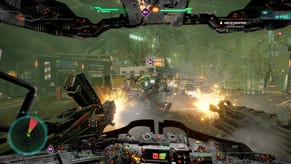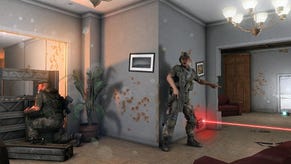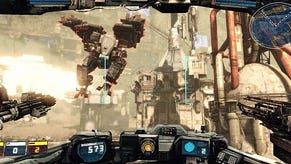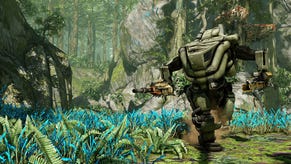Hands-On: Hawken
Oh, wot a wonderful war (machine)
If anyone was keeping count, they'd probably tell you that I died a lot more often than I killed at Gamescom. Whether having my head knocked off by a hammer or huddling around a fire and failing to survive the Eastern Front, I spent a lot of time meeting makers. Let it be known, however, that I was actually quite good at Hawken, but that's not the only reason I'm an admirer of the multiplayer deathmech delight.
Metal is alive. It walks, leaps, thunders, trips, stumbles, shakes, trembles, shrieks, warps, craters, creaks and burns with liquid intensity. Metal is alive but it is dying. Breaking apart along the very lines at which it was haphazardly welded together, the most solid of solid masses comes to a screaming, smouldering halt. Hawken's mechs, as befits their kitmashed kinetic power and thudding grace, have more physical presence than almost any other device in the virtual realms.
My mech was light, which made it like a small building rather than a tenement block, and as another victim burst into guttering flames following an onslaught from my overheating weaponry, Khang Le, creative director of Hawken's Adhesive Games, looked over my shoulder. "Ah, you're one of those players."
I'd used my jets to hover onto an overpass, cars blistering into twisted wreckage against the amored caps of my knees. From there it was a short leap, feet crunching onto the roof of one of the city block's crowded buildings, and I could zoom in and snipe away at the enemy team, waiting for a fight to break out before opening fire so as not to draw too much attention to myself. I liked that the game flashed up 'assist' whenever a mech I had been peppering from afar was exploded by a teammate.
True to form, even when sealed into a bipedal war-monster, a towering vertical tank with a jetpack, I choose to avoid the extremes of action, participating from a lofty vantage point. Not for me the valiant charge, the boost-assisted strafe that sends the machine sliding into a tunnel, slamming against the wall which spews dust and sparks. I rain EMP in arcing bolts onto my enemies and the watch as my team converges like a pack of wolves, the target's antlers now broken and no chance of the predators being punctured during the hunt.
That it's possible to be "one of those players" in a game which already seems to be characterised by claustrophobic cityscapes and chaotic close quarters combat was a wonderful surprise. Choosing a class of mech and its weapons and equipment reveals plenty of options, and not only in terms of size and weight. The selection of items, inspired in part by Duke Nukem 3D, allows for further tactical choices, with the aforementioned EMPs nestling on the cockpit controls alongside diversionary holograms, traps and tools. It's possible to opt for a loadout that aims for speed, meaning the game will be played with darting, surgical strikes, retreats and reparations, just as much as its possible to be the walking wall of armour and artillery that I'd expected having seen the videos.
This shouldn't distract from the fact that whatever their size, these are machines and they are cumbersome. It's psosible to dodge, to boost, to sail through the air, but everything feels like a man-on-machine (or man-in-machine) wrestling match. They don't want to dance, these intimidating constructs, they want to war, and this is reflected in the slight delay on their movements. Guns fire as soon as the trigger is pulled but try an evasive maneuvre, try to swivel on the spot and react to the flaring death on your six, and the screen lurches and sways into position.
Movement has weight, just as impact does, whether with a volley of missiles, one of the city's many vehicles caught up in the beautiful mess, or the side of a tower block. Hawken looks marvellous, the trailers haven't deceived, but it's not the glory of a PC being pushed to its limits, it's a precision of design. The screen is loaded with effects but rather than bloom and lens flare, here the art represents the dirt and debris that is the accompaniament to this particular brand of all-consuming urban warfare. In an eight minute round, thousands of projectiles are fired and each one sears through the air, a static stattaco burst of interference and heat.
It's a looker, is what I'm saying, just as the videos led us to expect. And the city isn't all that will be on show, with open desert at the other extreme of the settings that will be offered on release. Hawken is a game where you could stand still in a corner, probably looking at the floor, and you'd still see more things happening than in hours with most games. The city, like the metal, is alive and it too is dying, although it doesn't seem to care, with glorious neon advertisements hawking (ahem) their wares and what seem to be hovertrucks occasionally passing through the battle and then careening to the ground in dismay.
I mean, look, this is the kind of thing that just happens in the background. It'd be a dramatic QTE-based set piece in half the stuff out there.
Speaking to Le about the plans for release (full interview soon), I was eager to learn why the team had chosen to stomp along the free to play highway. It was something of a theme of Gamescom, me asking developers and publishers what they saw in free to play, and even if I wasn't always reassured I've returned to England determined to recognise, more specifically, the pros and cons on a case by case basis.
Hawken's post-release content will, so it is said at this stage, not split the community or allow advantages to big spenders. Well, not competitive advantages anyway. Paid content will, on the whole, be either entirely cosmetic or in the form of new mechs, adding variety rather than an edge over opponents. Given that the teams at play in my session were using everything from titanic heavy assault beasts to nippy advance scouts, it's reasonable to predict that while people will have a favourite, switching into a more suitable machine to suit a game mode or map will be the best approach. Having more choices would be a boon, then, but the base game should cover for all eventualities. The paid mechs might add nuance to a role, then, or simply look more dapper.
Any mooted single player content is likely to appear in what is essentially a separate game in the same world, or at least that seems to be the understanding at the moment. Episodic stories, following pilots and their stompy steeds, are a possibility, but for now, Hawken is a deathmatch game, or a team deathmatch game. It's a game about selecting, shooting and respawning. And it's one of the few games of that type that I can imagine watching other people play for pleasure, not because it's at the cutting edge, but because it has a too-rare verisimilitude. Of course these places and things are not real, but watching they way they react to every jolt, providing a wonderful noise of visual and aural feedback, is a distinct pleasure.
At one point, a heavy mech made its way onto my secluded rooftop and ran toward me, missiles streaking out in a deadly fan. I panicked. I hammered the 'w' key twice to propel myself forward at speed and we collided. The HUD broke down and for a moment it was like watching the world through fog, snow and static. Glimpses of the enemy's silhouette broke through, looking large, and then the interface rebooted itself, systems restored and I saw the heavy reeling, lights flickering across its surface as it went through a similar process.
I used the moment's confusion to scarper, plummeting over the edge and escaping into the warren of streets. The triumph of the terrified tactician out of his depth.
Hawken doesn't just have the looks that won it so much attention when it was first revealed, it has an extremely satisfying deathmatch core. The biggest surprise is the varied pace, which will be even more evident on other maps, or with teams of friends rather than strangers. It's not all sound and fury, although there's a huge amount of that, and for that I, and my tired and flinching mind, were extremely grateful.











